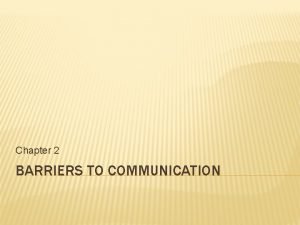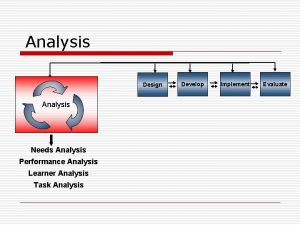The Adaptive Learner An Analysis of Differing Perspectives


- Slides: 2

The Adaptive Learner: An Analysis of Differing Perspectives Whereby Medical Students Tailor Resources to Advance Learning Crystal Graff¹ Kristina Kaljo Ph. D² Robert Treat Ph. D³ Kathryn Dielentheis MD² ¹Cohen Fellowship for Medical Education, ²Department of Obstetrics and Gynecology, ³Office of Academic Affairs Medical College of Wisconsin, Milwaukee, Wisconsin 53226 Background Results Ø Medical schools have historically utilized instructor-centered lectures to teach medical students the basic sciences. ¹ Ø Recently, students have become inundated with new, highquality resources to enhance lecture-based content. ² Ø The purpose of this study is to analyze perceptions between students and faculty regarding supplemental educational resources and the efficacy of lecture-based teaching. Fig 3: Resources Used by Students vs. Those Faculty are Aware Of Sketchy. Medical First. Aid You. Tube Public Websites Pathoma Ø In August 2017, separate surveys were sent to first-, secondand third-year students and basic science teaching faculty v A 13 -item survey was distributed to students, of which 155 of 711 (23%) responded. v An 11 -item survey was distributed to faculty, of which 81 of 376 (22%) faculty responded. Ø Survey items used categorical and 10 -point scales (10=high) and open-ended text-response. Mean scores compared with independent t-tests and Cohen’s d effect sizes. Percentage scores compared with Pearson chi-square tests. Pearson (r) and Spearman rho correlations used for relational analysis. IBM® SPSS® 24. 0 used for statistical analysis. Grounded theory utilized to analyze text to build an understanding of the participant’s realities. Study is IRB approved. Ø Students reported utilizing a significantly higher number of supplemental educational resources (mean (sd)=5. 9 (2. 0)) than faculty (4. 7 (2. 1)) perceived (Cohen’s d=0. 6, p<. 001) Ø Faculty’s perception of meeting students’ learning needs was rated significantly higher (7. 3 (1. 3)) than students (5. 9 (2. 0)) (Cohen’s d=1. 0/p<. 001) Fig 1: Correlation Between Meeting Learning Needs and Time Spent Seeking Additional Educational Resources Time Spent Seeking Resources Fig 2: Time Spent Seeking Out Additional Educational Resources to Supplement Lecture (chi 2= 22. 54, p<. 000) Percentage of Students Academic Enhancement Textbooks Study Groups Other Pre-Made Study Charts Anki Evidence-Based Journals Draw-it-to-Know-it Firecracker Individual Tutoring 0 25 50 75 100 % of Students/Faculty Results Learning r= -. 4 Needs Met Resources Methods Students Ø Faculty described lectures as the principal method of teaching, yet also highlighted the use of various teaching strategies: group work, clinical situations, and humor. Ø Several students reported being at a “disadvantage” because they could not afford some of the commonly used educational resources. Conclusion ØStudent and faculty perception’s regarding student learning needs were significantly different. ØStudents incur additional financial burdens as they personally finance supplemental resources to advance learning. ØIt is prudent for faculty and medical schools to be informed and provide access to essential educational tools to support the increasingly diverse student population. ³ References 1. Harden R, Sowden S, Dunn W. Educational Strategies in Curriculum Development: The SPICES Model. Med Educ. 1984; 18(4): 284 -297. 80 70 60 50 40 30 20 10 0 2. Conole G, de Laat M, Dillon T, Darby J. ‘Disruptive technologies’, ‘pedagogical innovation’: What’s new? Findings from an in-depth study of students’ use and perception of technology. Comput Educ. 2008; 50(2): 511– 24. Rarely Once per Week Every Other Day M 1 M 2 M 3 Every Day 3. Robin BR, Mc. Neil SG, Cook DA, Agarwal KL, Singhal GR. Preparing for the Changing Role of Instructional Technologies in Medical Education. Acad Med. 2011; 86(4): 435 -439.




